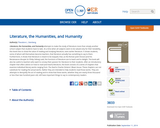
Short Description:
Return to milneopentextbooks.org to download PDF and other versions of this textNewParaLiterature, the Humanities, and Humanity attempts to make the study of literature more than simply another school subject that students have to take. At a time when all subjects seem to be valued only for their testability, this book tries to show the value of reading and studying literature, even earlier literature. It shows students, some of whom will themselves become teachers, that literature actually has something to say to them. Furthermore, it shows that literature is meant to be enjoyed, that, as the Roman poet Horace (and his Renaissance disciple Sir Philip Sidney) said, the functions of literature are to teach and to delight. The book will also be useful to teachers who want to convey their passion for literature to their students. After an introductory chapter that offers advice on how to read (and teach) literature, the book consists of a series of chapters that examine individual literary works ranging from The Iliad to Charles Dickens’ Bleak House. These chapters can not substitute for reading the actual works. Rather they are intended to help students read those works. They are attempts to demystify the act of reading and to show that these works, whether they are nearly three thousand or less than two hundred years old, still have important things to say to contemporary readers.
Long Description:
Literature, the Humanities, and Humanity attempts to make the study of literature more than simply another school subject that students have to take. At a time when all subjects seem to be valued only for their testability, this book tries to show the value of reading and studying literature, even earlier literature. It shows students, some of whom will themselves become teachers, that literature actually has something to say to them. Furthermore, it shows that literature is meant to be enjoyed, that, as the Roman poet Horace (and his Renaissance disciple Sir Philip Sidney) said, the functions of literature are to teach and to delight. The book will also be useful to teachers who want to convey their passion for literature to their students. After an introductory chapter that offers advice on how to read (and teach) literature, the book consists of a series of chapters that examine individual literary works ranging from The Iliad to Charles Dickens’ Bleak House. These chapters can not substitute for reading the actual works. Rather they are intended to help students read those works. They are attempts to demystify the act of reading and to show that these works, whether they are nearly three thousand or less than two hundred years old, still have important things to say to contemporary readers.
Word Count: 88076
ISBN: 978-1-942341-03-1
(Note: This resource's metadata has been created automatically by reformatting and/or combining the information that the author initially provided as part of a bulk import process.)
- Subject:
- English Language Arts
- Reading Literature
- Material Type:
- Textbook
- Provider:
- State University of New York
- Author:
- Theodore L. Steinberg
- Date Added:
- 09/11/2014
